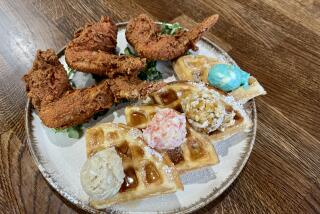Former Star of the Southwest : Blue Corn Makes Connection Coast to Coast
- Share via
ALBUQUERQUE, N.M. — Ross Edwards has the blues, and he wants you to have them too.
Blue corn chips, blue corn pancake and waffle mix, blue corn muffin mix, blue corn popcorn and blue corn meal ground coarse, medium or fine.
Edwards’ Blue Corn Connection ships the products coast to coast--New York City to Los Angeles; Buffalo Gap, Tex., to Ann Arbor, Mich. They primarily are sold in gourmet or health food stores, and in some restaurants and bars.
Why the demand for a chip some think looks moldy? Why the interest in a pancake mix some believe will turn teeth blue?
Riding Two Trends
Edwards attributes it to the surging interest in health food and Southwest cuisine.
“People are intrigued by a blue product,” he said.
Or hooked.
“We had a mail-order customer who used to live here. She became pregnant and moved out of state. She wrote us and said about the only thing she could eat was blue corn,” Edwards said.
The woman later sent Edwards a photograph of her child. “She said: ‘This is my boy who has the bluest eyes in the whole world.’ ”
He said some people wonder how he gets the blue in the corn. “Outside the Southwest there is a common suspicion that we just dyed it. We have to assure people it is the natural color.”
Edwards said his blue corn muffins, pancakes and waffles made of all-natural ingredients have a lighter texture than ordinary commercial mixes. He also claims they’re more flavorful.
‘Richer, Earthier’
“Some describe it as richer, earthier,” Edwards said. “Most of our products come across a little sweeter. Even though they are whole-grain, they are very light when people get them made correctly.
“Frequently, people say they never liked pancakes. They found them heavy or rubbery when they ate them out,” he said.
“I say, ‘You’re my favorite kind of customer--try this.’ They say: ‘This is a totally different texture. This I can eat.’ My mother-in-law was one of those,” Edwards said.
Blue Corn Connection sold $60,000 worth of blue corn products in its first full year of operation in 1985. Last year, sales pushed $400,000.
“In terms of corn, it’s going from something like 30,000 pounds of corn to 150,000 pounds of corn,” Edwards said.
Eight Work on Production
The company has eight employees working in a 2,000-square-foot warehouse rife with the nutty scent of roast corn and the sounds of three radios blaring rock, Spanish and country-western music.
In one room, four women stick labels on brown sacks to be filled with blue-gray pancake and waffle mix, muffin mix, corn meal, popcorn or chips.
In another tiny room, a miller named Marty Miller grinds blue corn in a red grinding machine. The meal is placed in barrels.
Next door is an area where meal and other ingredients are blended in a red cement mixer. Nearby, there’s a commercial popcorn popper.
The Blue Heaven line of mixes and popcorn has its roots in New Mexico, long known for its blue corn tortillas. Edwards, 41, an East Coast transplant, now has his roots in New Mexico too.
“I was a schoolteacher,” he said. “I didn’t teach. I held ground in a junior high school in the South Bronx.
“I couldn’t hack New York City anymore and decided to make a complete break. I moved to New Mexico in 1970 and have been here ever since.”
Edwards said he knocked around for awhile and did odd jobs.
In Albuquerque, he opened a yogurt company that he ran with a partner for a time. Then came more odd jobs, followed by four years as a plumber.
Learns the Business
He was solicited by friends who ran a food co-op. He stayed about six years, learning every aspect of the business.
“I was always a big fan of blue corn meal myself, and I started thinking about a process of marketing blue corn,” he said.
“Tortilla makers were the biggest users of blue corn a few years ago. I wanted to present it in a different way.”
About five years ago, he started to produce small batches of the pancake mix to sell at the co-op. “We got very good response to the product right off the bat,” Edwards said. “People were really excited about it. We started giving the project a little more attention.”
The co-op began to market the product around the Southwest, and Edwards decided to pursue the project more seriously.
He trademarked the name Blue Heaven and began plans for his own company to market blue corn products.
When the co-op came on hard times and closed in the fall of 1984, Edwards said he “just dove in and bought equipment that was there and inventory and started in on it in October of 1984.”
More to Read
Eat your way across L.A.
Get our weekly Tasting Notes newsletter for reviews, news and more.
You may occasionally receive promotional content from the Los Angeles Times.









